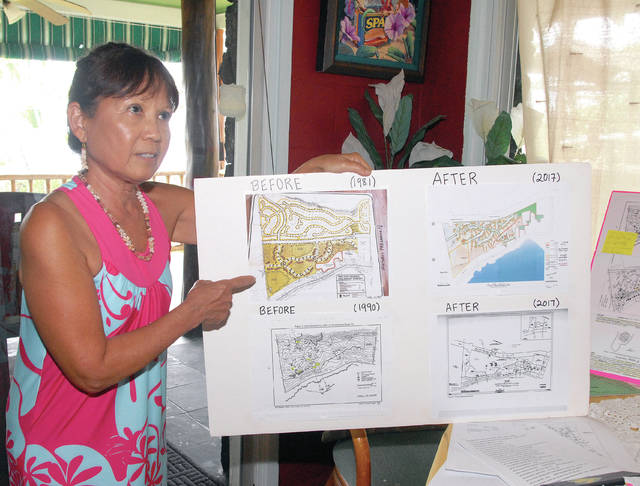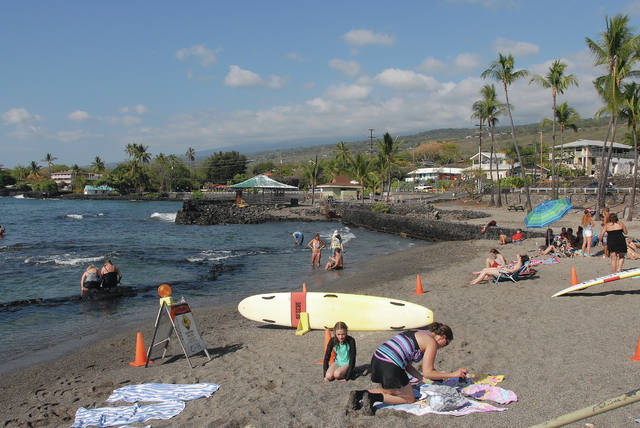KAILUA-KONA — Citing a “need for a deeper awareness and understanding” of historically and culturally significant sites in a Kahaluu parcel eyed for development of a 306-unit condominium, the county’s planning director is asking the officer overseeing the contested case
KAILUA-KONA — Citing a “need for a deeper awareness and understanding” of historically and culturally significant sites in a Kahaluu parcel eyed for development of a 306-unit condominium, the county’s planning director is asking the officer overseeing the contested case to reopen the hearing to hear more evidence and testimony from himself and other potential witnesses.
None of the documents filed as part of the motion express any outright change in position on the project, only going so far as to ask the hearing be re-opened to take more evidence and testimony.
The director previously recommended that the commission approve the request to allow for the project’s development, though he reserved the right to modify or alter that position based on additional information.
“After hearing and reviewing the public testimony, the planning director … considers this information to be newly discovered evidence,” stated a memorandum attached to the motion to reopen the hearing, “and as such, may revise his recommendation and provide additional testimony in this contested case.”
Simmy McMichael, the Kahaluu resident whose petition for a contested case hearing the Leeward Planning Commission granted in April 2016, said she was excited about what the filing could mean for the issue.
“There is a ray of hope,” she said.
The controversy is centered on a proposed 306-unit timeshare condominium proposed to be built on a 42-acre parcel of land mauka of Alii Drive in Kahaluu.
That property is owned by Kamehameha Investment Corp. and is zoned for resort, multi-family residential and single-family residential uses, according to a final environmental assessment for the project.
An environmental assessment was required because most of the project site is situated within the Kahaluu Historic District, which is included on the National Register of Historic Places, according to that assessment.
The proposal to build that development though has faced opposition from area residents, who have cited historically and culturally significant sites in the area as well as impacts to area resources and infrastructure in a bid to stop the project.
The project’s final environmental assessment indicated 58 sites consisting of 247 features, such as platforms mounds, a burial crypt and others.
While all were deemed significant, only some sites, including the Great Wall of Kuakini and those identified as burials or possible burials were marked for preservation and specific preservation areas were included on maps of the proposed project area.
The final assessment ultimately concluded that the project “will not have significant environmental effects.”
The recent contested case hearing took place over three days in April and May and included testimony from several experts whose studies on the site environment were cited in the final environmental assessment.
Those hearings also featured several hours of public testimony from residents, many of whom voiced strong opposition to any development of the land parcel.
On May 15, the hearings officer closed the evidentiary portion of the hearing and said he would issue his final recommendation to the Leeward Planning Commission by June 29.
On Friday though, an attorney for planning director Michael Yee filed a motion to reopen the hearing “for the purpose of receiving further evidence and testimony from planning director Yee and any other witnesses determined to be necessary by the hearings officer.”
In an attached declaration, Yee wrote that after considering some of the public testimony presented at the hearing, he now finds “that there is a need for a deeper awareness and understanding of the historical and cultural significance of not only the individual archaeological features and sites located within the project site, but also of those lands located both mauka and makai of Alii Drive and situated within the same ahupuaa of Kahaluu, as generally identified by the Kahaluu Historic District.”
Because the petition area is within the larger area defined as the Kahaluu Historic District, Yee said that fact “compels this office to also view the petition area as linked, historically and culturally, to the larger historic district as represented by public testimony.”
Yee in his declaration specifically referenced the testimony of individuals like Mitchell Fujisaka, whose roots in Kahaluu go back generations.
Fujisaka in April voiced his opposition to the development in public testimony, saying “kapu is kapu.”
“It’s no, no, no,” the man said at the time.
Yee also referenced testimony from Mandy Campbell, an archaeologist and environmental compliance specialist who said a map in the case record incorrectly plots the district’s boundaries.
McMichael said the filing is a “big step forward.”
“Because they’re getting it,” she said. “They’re getting why we’re so strongly opposing this 306-unit timeshare on this property.”
Yee could not be reached for comment on Saturday, nor could a representative from the developer.




